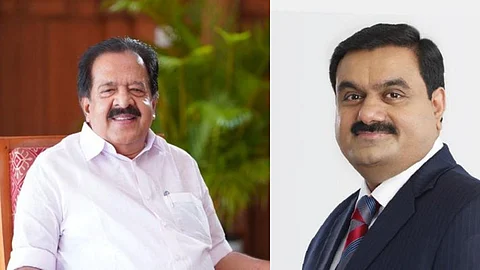

Kerala's senior Congress leader Ramesh Chennithala has alleged that the power tariff hike effected by the state government is aimed at benefiting the Adani Group.
Chennithala alleged that the long-term power purchase agreement signed by the United Democratic Front Government headed by Oommen Chandy in 2016 to buy electricity at rates below Rs 5 per unit was cancelled during the Pinarayi Vijayan-headed Left Democratic Front government. This was to facilitate the entry of Adani into the power purchase system.
The state government on Friday announced a 16 paise per unit increase in electricity tariffs for the 2024-25 financial year. An additional hike of 12 paise per unit is set to follow in the 2025-26 financial year.
Chennithala alleged the government's decision showed that it was in collusion with the power-producing companies, especially the Adani Group. "Adani is the biggest beneficiary of this power tariff hike. The government's decision is aimed at bringing the Adani Group into the power purchasing system in Kerala," he claimed. He said that the government was now buying electricity at high rates of between Rs 10-14 per unit.
Friday's power tariff hike marked the fifth tariff increase since the Pinarayi government took office in 2016. Kerala’s Electricity Minister, K Krishnankutty, says that the increase is minimal and will not have much impact on household budgets.
The Kerala State Electricity Board (KSEB) initially requested a higher increase of 37 paise per unit for 2024-25 and 27 paise per unit for 2025-26. However, the Electricity Regulatory Commission approved smaller hikes of 16 paise and 12 paise per unit, respectively. A proposed increase of 9 paise per unit for the 2026-27 financial year was also rejected by the commission.
The tariff increase will apply to consumers using more than 40 units of electricity per month, with a connected load exceeding 1,000 watts. Fixed charges for both single-phase and three-phase connections will also rise. For example, customers using between 201 and 250 units per month will pay an additional 30 paise per unit starting in the 2025-26 financial year.
However, there will be some relief for certain groups. Households using up to 250 units per month during the daytime will benefit from a 10% reduction in tariffs, thanks to the growing use of solar power. This initiative is expected to help around five lakh consumers.
Additionally, families living below the poverty line, as well as those with cancer patients or permanent disabilities, will not see any tariff increase. Their connected load limit has also been raised from 1,000 watts to 2,000 watts.
The minister also said that if the cost of electricity from external sources decreases, the savings will be passed on to consumers.